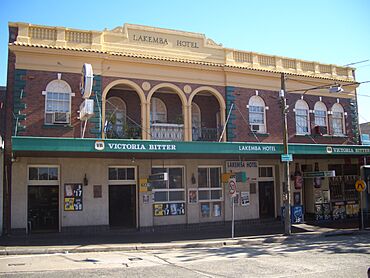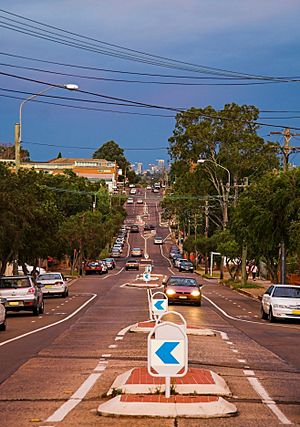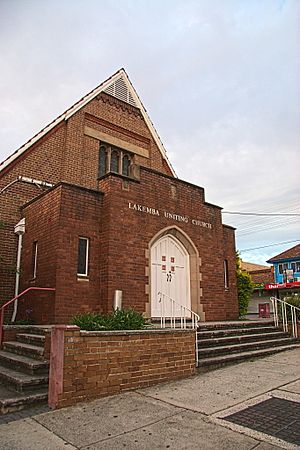Lakemba, New South Wales facts for kids
Quick facts for kids LakembaNew South Wales |
|||||||||||||||
|---|---|---|---|---|---|---|---|---|---|---|---|---|---|---|---|

Lakemba Hotel
|
|||||||||||||||
| Population | 17,092 (2021 census) | ||||||||||||||
| Postcode(s) | 2195 | ||||||||||||||
| Elevation | 38 m (125 ft) | ||||||||||||||
| Location | 12 km (7 mi) WSW of Sydney CBD | ||||||||||||||
| LGA(s) | City of Canterbury-Bankstown | ||||||||||||||
| State electorate(s) | Canterbury | ||||||||||||||
| Federal Division(s) | Watson | ||||||||||||||
|
|||||||||||||||
Lakemba is a lively suburb located in Western Sydney, New South Wales, Australia. It's about 12 kilometres southwest of the main city area of Sydney. Lakemba is part of the City of Canterbury-Bankstown local council.
Contents
Geography and Environment
Lakemba is located in the area where water flows into the Cooks River. This river has tides that reach the edge of Lakemba.
- Rivers and Trails
A special path for bikes and walkers follows the Cooks River. You can follow this path from nearby Belfield in the east. It goes all the way to where the river meets Botany Bay. If you go the other way, the path leads north to Olympic Park. It also reaches Homebush Bay on the Parramatta River.
- Canterbury Road
Canterbury Road is a main road that runs along a high ridge. This ridge separates the areas where water flows into the Cooks River and Wolli Creek. The road is close to the shops on Haldon Street.
History of Lakemba
The area now known as Lakemba was once called Potato Hill. This was because farmers grew many potatoes there.
- Early Land Grants
The first land grants from the government started around 1810. Samuel Hockley received 50 acres (about 20 hectares). He named his farm Essex Hill Farm, after his home county in England. Before 1910, the suburb was known as Belmore South.
- How Lakemba Got Its Name
In the 1880s, a man named Benjamin Taylor owned a large property. He named it "Lakeba" (pronounced Lakemba). This name came from an island in Fiji called Lakeba. His second wife's grandparents were missionaries on that island. One of the streets in Lakemba, Oneata Street, is also named after a small Fijian island. Benjamin Taylor was an important person in the local council. He was an alderman and even the Mayor of Canterbury Council.
- Railway and Post Office
The railway line reached the nearby suburb of Belmore in 1895. It was extended to Lakemba and other areas in 1909. The Lakemba train station was built on Benjamin Taylor's land. It was named after his home, 'Lakemba Cottage'. The post office in Lakemba opened on 1 July 1920.
- Schools in the Area
The first school opened in April 1869 as Belmore School. It was called Belmore South from 1907 until July 1969. Then, its name was changed to Lakemba Public School.
- A Growing Community
After World War II, many new people moved to Lakemba. Immigrants from Greece, Italy, and later, from the Middle East, Southeast Asia, and the Pacific Islands, settled here. From the 1950s, Lakemba became a very multicultural place. This mix of cultures has made Lakemba a vibrant and diverse suburb, which continues today. In the 21st century, more immigrants from places like Iraq and Syria have also made Lakemba their home.
People and Culture (Demographics)
In the 2021 Census, there were 17,092 people living in Lakemba.
- Diverse Backgrounds
Lakemba has always had a mix of people. In the 1800s, the first non-Aboriginal settlers were mainly from Britain and Ireland. By the mid-1900s, many people from Greece and Italy moved to the suburb. Local shops and clubs, like Greek delicatessens, showed this Mediterranean influence.
- Modern Diversity
From the mid-1970s, many migrants from Lebanon settled in Lakemba. By the 1990s, it was seen as a main centre for Lebanese Australian life. The Lakemba Mosque and special shops for Arab and Muslim cultures made many people think Lakemba was mostly Arab and Muslim. However, the 2021 census shows that Lakemba is much more diverse. Only 6.4% of residents said their background was Lebanese. The largest group by background is Bangladeshi.
- Where People Are From
In 2021, 32.0% of people in Lakemba were born in Australia. The next most common countries of birth were Bangladesh (15.0%), India (8.8%), Pakistan (5.3%), Myanmar (4.3%), and Lebanon (3.4%).
- Languages Spoken
Only 16.6% of people spoke only English at home. Other languages spoken included Bengali (18.5%), Urdu (13.2%), Arabic (10.5%), Vietnamese (3.8%), and Rohingya (3.2%).
- Religions
In 2021, the most common religion was Islam (61.2%). Other religions included Catholic (8.8%) and Eastern Orthodox (3.4%). Some people also reported no religion (6.7%) or did not state their religion (10.1%).
Transport in Lakemba
Lakemba railway station is on the Bankstown railway line. The train line was extended to Lakemba in 1909. It became an electric train line in 1926.
- Metro Upgrade
The station was temporarily closed on 30 September 2024. This was to change the line to Sydney Metro standards. This work is part of the Sydney Metro City & Southwest project. The upgrades were completed by 2025. Now, Metro North West & Bankstown Line trains run every 4 minutes during busy times. Travel times from Lakemba to Central have decreased from 28 minutes to 22 minutes.
- Bus Services
For more information about bus services, you can check the Lakemba station page.
Residential and Commercial Areas
Lakemba is often mentioned in the news because it is more affordable than other parts of Sydney. This is especially true for how close it is to the city centre.
- Housing and Growth
Lakemba was the best-performing suburb for property growth over the 10 years leading up to 2020. More growth is expected because of the new Sydney Metro City & Southwest line. This will make travel to the city faster. It will also bring new homes and businesses to the area. Lakemba is also known as one of the last places in Sydney where buying a home can be cheaper than renting.
- Shopping and Food
Lakemba has many shops on and around Haldon Street. Here, you can buy a wide variety of international and local foods. There are also many businesses along Canterbury Road.
- Lakemba Ramadan Markets
The Lakemba Ramadan Markets on Haldon Street are a popular nightly food market. They happen during the month of Ramadan. People from all over Australia visit Lakemba for these market nights. The markets and their food are so popular that they attract thousands of people every week, even outside of Ramadan.
Places of Worship
Lakemba has many places of worship for its diverse population. These include:
- St Therese Catholic Church
- Lakemba Uniting Church
- Lakemba Presbyterian Church
- Several Mosques, such as Darul Ulum Sydney, Lakemba Mosque, Ernest Street Masjid, Lakemba Musalla, and Ahl Al Sunna Wal Jamaah Association Musallah.
- St. Andrew's Anglican Church
The St. Andrew's Anglican Church is at the corner of Quigg and Lakemba Street. It was built in 1923 from bricks. It has a beautiful collection of stained glass windows. The first church building was made of wood. It was later made bigger and became the parish hall.
Schools in Lakemba
Lakemba has several schools, both public and private:
- Lakemba Public School
- Hampden Park Public School
- Canterbury Vale School
- St Therese Primary School
- Holy Spirit College
- Rissalah College
- AlHikma College
Politics and Representation
Lakemba is the name of one of the areas that elects a representative to the New South Wales Parliament.
- State and Federal Representatives
The Electoral district of Lakemba is currently represented by Jihad Dib. He is from the Australian Labor Party. The person who represents Lakemba in the national Parliament (Federal Member of Parliament) is Tony Burke.
Lakemba Fire Station
The Lakemba Fire Station was built in 1921. It was built by the Board of Fire Commissioners of New South Wales. At first, it had both full-time firefighters and volunteers. The station cost $13,950.00 to build. It is located at 208 Haldon Street.




